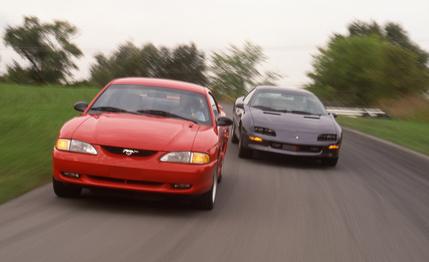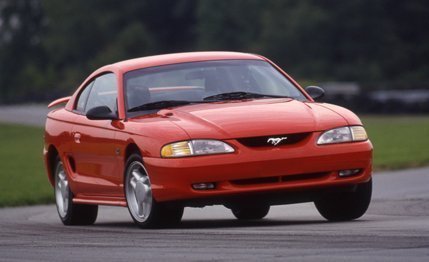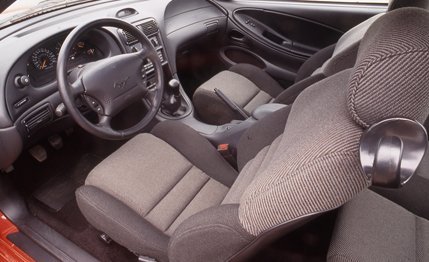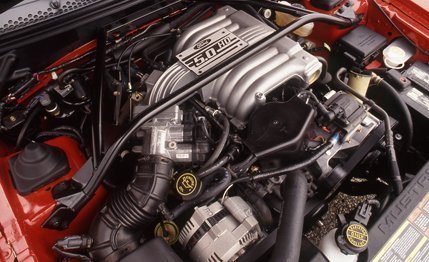
 Archived Comparison
Archived Comparison
Thirty years ago, in the spring of 1964, Ford invented the American two-plus-two sporty coupe when it popped the Mustang on an eager public—a public that responded by ordering 22,000 cars the first day. Chevrolet was caught flat-footed and had to spot the Mustang more than a million sales before responding with the Camaro in the fall of 1966. Chevy's pony car quickly established itself as the Mustang's most bitter rival, and the two have been brawling ever since—in showrooms, on racetracks, and between the covers of magazines.


The fortunes of war have varied over the decades. But the report from the front as 1994 gets underway shows the tide clearly running in Chevrolet's favor. Against a commendably smooth and refined new Mustang, the Camaro—redesigned last year for its fourth generation—more than holds its own. In fact, it kicks pony tail. In nearly every performance measurement we take, the Camaro Z28 runs all over the Mustang GT.


As you'd predict for otherwise similar cars, the 275-horsepower Camaro creams the 215-horsepower Mustang in sheer speed. Our Z28 lunged to 60 mph in 5.4 seconds, while the GT needed 6.1. By the 130-mph mark, the gap had ballooned with the Z28 reaching that speed in 26.6 seconds, versus 44.7 for the GT. The Camaro ran the quarter-mile in 14.1 seconds at 101 mph, the Mustang in 14.9 seconds at 93 mph. Top speed? Same story. Camaro: 156. Mustang: 137.
How about the contests that don't reward brute power? The Camaro still held the upper hand. It generated 0.86 g on the skidpad to the Mustang's 0.85, and stopped from 70 mph in 167 feet, versus the GT's 179. Around the short, 1.5-mile Waterford Hills roadcourse, the Z28 consistently lapped a solid second faster, averaging 1:26.1 to 1:27.2 for the GT.
Of course, performance figures do not tell the whole story. The new-generation Mustang GT is a much sweeter automobile than this evidence suggests. As we reported in a preview drive (October 1993), Ford's work to improve the structural rigidity and suspension control of this chassis has paid impressive dividends. The Mustang has a tight, polished feel that we would not have thought possible from a platform whose roots are in the 1978 Fairmont. Still, a shoot-out is a shoot-out, and the tradition of Camaro-Mustang faceoffs gives little credit for finishing second at the track.


Had the Z28's performance advantage come at a huge cost in such areas as ride comfort, ergonomics, and noise control, we might feel more reserved about its dominance. But in truth, the Camaro is a refined piece as well. Ride quality is marginally stiffer than the Mustang's but still entirely acceptable. And the extra racket is almost all V-8 rumble—hardly objectionable in this kind of car.
The Camaro has a much racier feel, an impression that begins when you plop into the driver's seat. It's a wide, low car, and the driver looks out through a radically raked windshield and over a rapidly dropping nose. By contrast, you sit bolt-upright in the narrower Mustang, the higher hood running out to a blunt front end.
In both cars, the driver is surrounded by interiors and instrument panels that are efficiently laid out, but the Mustang's clean design is easier to look at. The Camaro's gauge cluster is garish by comparison, but at least its instrument faces are now marked in white rather than the jarring yellow of last year.


Seat comfort is better in the Mustang, even with some pressure points at the lower back and under the thighs. The Camaro's seats are flatter and feel less well made, offering little retention in hard cornering, and they move around annoyingly due to frame flex and mounting slack. Neither back seat offers more than minimal room, but most passengers preferred the higher cushion location of the Mustang.
Light off the V-8 engines and they give vastly different impressions. The Mustang's 302 almost suggests the quiet "adequacy" of a Bentley Turbo R, while the Camaro's rowdy 350 sounds straight out of an old Can-Am car. Both are flexible, strong, and smooth-running, with lively throttle response and good fuel efficiency (both are projected to get 17 mpg on the EPA city cycle). When you want to get out of town, or just out of a corner, neither V-8 cares much whether it's turning 2500 rpm or 4500.